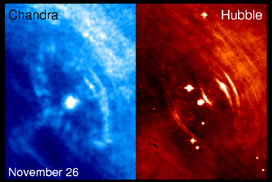Imagine the Universe News - 20 September 2002
Space Movie Reveals Shocking Secrets of the Crab Pulsar
| 20 September 2002 |

|
|
This movie shows dynamic rings, wisps and jets of matter and antimatter
around the pulsar in the Crab Nebula as observed in X-ray light by
Chandra (left, blue) and optical light by Hubble (right, red).
(IMAGE CREDIT: NASA/CXC/HST/ASU/J. Hester et al) (Click on image to start movie) |
Just when it seemed the summer movie season had ended, two of NASA's Great Observatories have produced their own action movie. Multiple observations made over several months with NASA's Chandra X-ray Observatory and the Hubble Space Telescope captured the spectacle of matter and antimatter propelled to nearly the speed of light by the Crab pulsar.
"Through this movie, the Crab Nebula has come to life," said Jeff Hester of Arizona State University in Tempe, lead author of a paper in the September 20 issue of The Astrophysical Journal Letters. "We can see how this awesome cosmic generator actually works."
The Crab was first observed by Chinese astronomers in 1054 A.D. and has since become one of the most studied objects in the sky. By combining the power of Chandra and Hubble, the movie reveals features never before seen in still images. By understanding the Crab, astronomers hope to unlock the secrets of how similar objects across the universe are powered.
The movie provides a stunning view of the activity in the inner region around the Crab Nebula pulsar, which is seen as a bright white dot near the center of the images. Bright wisps can be seen moving outward at half the speed of light to form an expanding ring, visible in both X-ray and optical images. These wisps appear to originate from a shock wave that shows up as an inner X-ray ring.
The inner X-ray ring consists of about two dozen knots that form, brighten and fade, jitter around, and occasionally undergo outbursts that give rise to expanding clouds of particles, but remain in roughly the same location. As a high-speed wind of matter and antimatter particles from the pulsar plows into the surrounding nebula, it creates a shock wave and forms the inner ring. Energetic shocked particles move outward to brighten the outer ring and produce an extended X-ray glow.
Enormous electrical voltages generated by the rotating, highly magnetized neutron star accelerate particles outward along its equator to produce the pulsar wind. These pulsar voltages also produce the polar jets seen spewing X-ray emitting matter and antimatter particles perpendicular to the rings.
"These data leave little doubt that the inner X-ray ring is the location of the shock wave that turns the high-speed wind from the pulsar into extremely energetic particles," said Koji Mori of Penn State University in University Park, a coauthor of the paper.
Another dramatic feature of the movie is a turbulent jet that lies perpendicular to the inner and outer rings. Violent internal motions are obvious, as is a slow motion outward into the surrounding nebula of particles and magnetic field.
"The jet looks like steam from a high-pressure boiler," said David Burrows of Penn State, another coauthor of the paper, "except when you realize you are looking at a stream of matter and anti-matter electrons moving at half the speed of light!"
The inner region of the Crab Nebula around the pulsar was observed with Hubble on 24 occasions between August 2000 and April 2001 at 11-day intervals, and with Chandra on eight occasions between November 2000 and April 2001. The Crab was observed with Chandra's Advanced CCD Imaging Spectrometer and Hubble's Wide-Field Planetary Camera.

